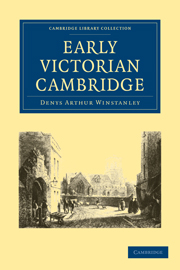Book contents
- Frontmatter
- Contents
- Preface
- Chapter I THE FOUNDATION OF DOWNING COLLEGE
- Chapter II A COLLEGE ELECTION
- Chapter III UNDERGRADUATES IN BONDS
- Chapter IV THE ATTACK ON HEADS OF HOUSES
- Chapter V CHRISTOPHER WORDSWORTH
- Chapter VI THE RELIGIOUS TESTS
- Chapter VII CHANCELLORS AND HIGH STEWARDS
- Chapter VIII TOWN AND GOWN
- Chapter IX TROUBLE AT THE FITZ WILLIAM
- Chapter X INTERNAL REFORM
- Chapter XI THE ROYAL COMMISSION
- Chapter XII BETWEEN THE TWO COMMISSIONS
- Chapter XIII STATUTE XLI AND THE THREE REGIUS PROFESSORSHIPS
- Chapter XIV THE STATUTORY COMMISSION AND THE UNIVERSITY
- Chapter XV THE STATUTORY COMMISSIONERS AND TRINITY COLLEGE
- Chapter XVI CAMBRIDGE AS IT WAS
- Appendices
- A Fellowships of Trinity College
- B The Trinity Seniority
- C Sir Isaac Newton's rooms
- D The statue of Isaac Barrow in Trinity Chapel
- Index
C - Sir Isaac Newton's rooms
Published online by Cambridge University Press: 07 September 2010
- Frontmatter
- Contents
- Preface
- Chapter I THE FOUNDATION OF DOWNING COLLEGE
- Chapter II A COLLEGE ELECTION
- Chapter III UNDERGRADUATES IN BONDS
- Chapter IV THE ATTACK ON HEADS OF HOUSES
- Chapter V CHRISTOPHER WORDSWORTH
- Chapter VI THE RELIGIOUS TESTS
- Chapter VII CHANCELLORS AND HIGH STEWARDS
- Chapter VIII TOWN AND GOWN
- Chapter IX TROUBLE AT THE FITZ WILLIAM
- Chapter X INTERNAL REFORM
- Chapter XI THE ROYAL COMMISSION
- Chapter XII BETWEEN THE TWO COMMISSIONS
- Chapter XIII STATUTE XLI AND THE THREE REGIUS PROFESSORSHIPS
- Chapter XIV THE STATUTORY COMMISSION AND THE UNIVERSITY
- Chapter XV THE STATUTORY COMMISSIONERS AND TRINITY COLLEGE
- Chapter XVI CAMBRIDGE AS IT WAS
- Appendices
- A Fellowships of Trinity College
- B The Trinity Seniority
- C Sir Isaac Newton's rooms
- D The statue of Isaac Barrow in Trinity Chapel
- Index
Summary
There is a Trinity tradition that Sir Isaac Newton, during the latter part of his life in college, occupied the set of rooms now known as E 4 Great Court; and it is more securely founded than most traditions. There is direct evidence for it. An entry in the Junior Bursar's Books for the year ending Michaelmas, 1683, reports “mending the wall betwixt Mr Newton's garden and St John's”; and this garden must clearly have belonged to a set on E staircase. And there is little doubt as to the particular set to which it belonged. The record of occupants of college rooms, which, unfortunately, was not systematically kept before the nineteenth century, shows that H. J. Hotham, a Fellow of the college, occupied E4 Great Court from 1853 to 1866; and Romilly in his diary mentions a scheme, discussed at a meeting of the Seniority on 1 June 1855, “of rounding off a part of Hotham's garden, and throwing the boundary wall back, so as nearly to touch the chapel”. It is, of course, conceivable that within the space of almost two hundred years the garden might have been detached from one set and connected with another; but the entry in the Junior Bursar's Books is not the only testimony to the truth of the tradition.
There is a chain of indirect evidence. The first link in it is supplied by Richard Cumberland, Bentley's grandson, who was born in Trinity Lodge, and began residence as an undergraduate of the college about 1747.
- Type
- Chapter
- Information
- Early Victorian Cambridge , pp. 434 - 435Publisher: Cambridge University PressPrint publication year: 2009First published in: 1940



